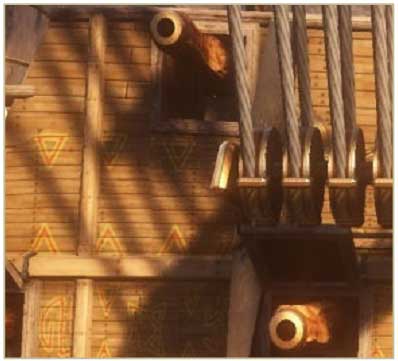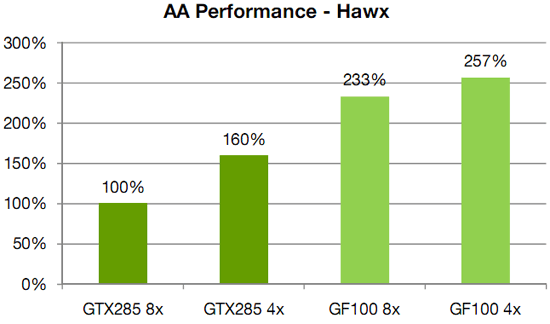Better Image Quality: Jittered Sampling & Faster Anti-Aliasing
As we’ve stated before, the DX11 specification generally leaves NVIDIA’s hands tied. Without capsbits they can’t easily expose additional hardware features beyond what DX11 calls for, and even if they could there’s always the risk of building hardware that almost never gets used, such as AMD’s Tessellator on the 2000-4000 series.
So the bulk of the innovation has to come from something other than offering non-DX11 functionality to developers, and that starts with image quality.
We bring up DX11 here because while it strongly defines what features need to be offered, it says very little about how things work in the backend. The Polymorph Engine is of course one example of this, but there is another case where NVIDIA has done something interesting on the backend: jittered sampling.
Jittered sampling is a long-standing technique used in shadow mapping and various post-processing techniques. In this case, jittered sampling is usually used to create soft shadows from a shadow map – take a random sample of neighboring texels, and from that you can compute a softer shadow edge. The biggest problem with jittered sampling is that it’s computationally expensive and hence its use is limited to where there is enough performance to pay for it.

In DX10.1 and beyond, jittered sampling can be achieved via the Gather4 instruction, which as the name implies is the instruction that gathers the neighboring texels for jittered sampling. Since DX does not specify how this is implemented, NVIDIA implemented it in hardware as a single vector instruction. The alternative is to fetch each texel separately, which is how this would be manually implemented under DX10 and DX9.

NVIDIA’s own benchmarks put the performance advantage of this at roughly 2x over the non-vectorized implementation on the same hardware. The benefit for developers will be that those who implement jittered sampling (or any other technique that can use Gather4) will find it to be a much less expensive technique here than it was on NVIDIA’s previous generation hardware. For gamers, this will mean better image quality through the greater use of jittered sampling.
Meanwhile anti-aliasing performance overall received a significant speed boost. As with AMD, NVIDIA has gone ahead and tweaked their ROPs to reduce the performance hit of 8x MSAA, which on previous-generation GPUs could result in a massive performance drop. In this case NVIDIA has improved the compression efficiency in the ROPs to reduce the hit of 8x MSAA, and also cites the fact that having additional ROPs improves performance by allowing the hardware to better digest smaller primitives that can’t compress well.

NVIDIA's HAWX data - not independently verified
This is something we’re certainly going to be testing once we have the hardware, although we’re still not sold on the idea that the quality improvement from 8x MSAA is worth any performance hit in most situations. There is one situation however where additional MSAA samples do make a stark difference, which we’ll get to next.










115 Comments
View All Comments
Zool - Tuesday, January 19, 2010 - link
There are still plenty of questions.Like how tesselation efects MSAA with increased geametry per pixel. Also the flat stairs in uniengine (and very plastic, realistic after tesselation and displacement mapping), would they work with collision detection as after tesselation or before as completely flat and somewhere else in the 3d space. The same with some physix efects. The uniengine heaven is more of a showcase of tesselation and what can be done than a real game engine.
marraco - Monday, January 18, 2010 - link
Far Cry Ranch Small, and all the integrated benchmark, reads constantly the hard disk, so is dependent of HD speed.It's not unfair, since FC2 updates textures from hard disk all the time, making the game freeze constantly, even in the better computers.
I wish to see that benchmark run with and without SSD.
Zool - Monday, January 18, 2010 - link
I want also note that for the stream of fps/3rd person shooters/rts/racing games that look all same sometimes upgrading the graphic card doesnt have much sense these days.Can anyone make a game that will use pc hardware and it wont end in running and shoting at each other from first or third person ? Dragon age was a quite weak overhyped rpg.
Suntan - Monday, January 18, 2010 - link
Agreed. That is one of the main reasons I've lost interest in PC gaming. Ironically though, my favorite console games on the PS3 have been the two Uncharted games...-Suntan
mark0409mr01 - Monday, January 18, 2010 - link
Does anybody know if Fermi, GF100 or whatever it's going to be called have support for bitstream of HD audio codecs?Also do we know anything else about the video capabilites of the new card, there doesn't really seem to have been much mentioned about this.
Thanks
Slaimus - Monday, January 18, 2010 - link
Seeing how the GF100 chip has no display components at all on-chip (RAMDAC, TMDS, Displayport, PureVideo), they will probably be using a NVIO chip like the GT200. Would it not be possible to just put multiple NVIO chips to scale with the number of display outputs?Ryan Smith - Wednesday, January 20, 2010 - link
If it's possible, NVIDIA is not doing it. I asked them about the limit on display outputs, and their response (which is what brought upon the comments in the article) was that GF100 cards were already too late in the design process after they greenlit Surround to add more display outputs.I don't have more details than that, but the implication is that they need to bake support for more displays in to the GPU itself.
Headfoot - Monday, January 18, 2010 - link
Best comment for the entire page, I am wondering the same thing.Suntan - Monday, January 18, 2010 - link
Looking at the image of the chip on the first page, it looks like a miniature of a vast city complex. Man, when are they going to remake “TRON”……although, at the speeds that chips are running now-a-days, the whole movie would be over in a ¼ of a second…
-Suntan
arnavvdesai - Monday, January 18, 2010 - link
In you conclusion you mentioned that the only thing which would matter would be price/performance. However, from the article I wasnt really able to make out a couple of things. When NVIDIA says they can make something look better than the competition, how would you quantify that?I am a gamer & I love beautiful graphics. It's one of the reasons I still sometimes buy games for PCs instead of consoles. I have a 5870 & a 1080p 24" monitor. I would however consider buying this card if it made my game look better. After a certain number(60fps) I really only care about beautiful graphics. I want no grass to look like paper or jaggies to show on distant objects. Also, will game makers take advantage of this? Unlike previous generations game manufacturers are very deeply tied to the current console market. They have to make sure the game performs admirably on current day consoles which are at least 3-5 years behind their PC counterparts, so what incentive do they have to try and advance graphics on the PC when there arent enough people buying them. I am looking at current games and frankly just playing it, other than an obvious improvement in framerate, I cannot notice any visual improvements.
Coming back to my question on architecture. Will this tech being built by Nvidia help improve visual quality of games without additional or less additional work from the game manufacturing studios.